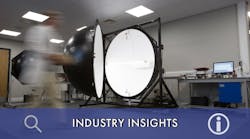As the industry awaits word from ams Osram on whether it will continue at all with its written-down micro LED business, one market research group has weighed in with an opinion: Yes, it will, but in a vastly reduced manner, and minus the factory in which ams sunk outsized investment.
For those who might have missed it: Premstaetten, Austria–based ams Osram two weeks ago announced that it will write down its micro LED operations by between €600 million ($656 million) and €900 million ($984 million) following the loss of a strategic customer — likely Apple — that had agreed to make substantial pre-payments.
Ams Osram had been relying on the customer and the pre-payments since at least 2022 to help justify its spending on a new factory in Kulim, Malaysia which at nearly $1 billion had pushed capital expenditures to well over the company’s normal levels. Ams Osram had been forecasting that substantial revenue would start in 2025. It is believed that Apple had been planning to use the micro LEDs in future models of the Apple Watch, although ams Osram has not publicly identified the customer.
When ams Osram announced the write-down in late February, it said it would “reassess the micro LED strategy.” LEDs Magazine inquired at the time whether an exit was possible. “There is no final decision yet,” a company spokesperson replied. “As soon as there are results and decisions, we will give an update. I can’t tell you the timeframe. The process has now started. I don’t think it will take too long.”
Meanwhile, French semiconductor research outfit Yole Group observed soon after the announcement that ams Osram will pull out of the Kulim plant, but will continue to make micro LEDs at its Regensburg, Germany facility.
Lyon-based Yole cited Apple’s cancellation of a micro LED–based watch (Apple currently uses an OLED display technology) as the culprit in the ams Osram write-down.
“The news came as a shock,” Yole wrote in the report. “Apple pulled the plug on their micro LED effort for the future smartwatch that was anticipated to be released by 2026. Hundreds of people working at the company’s secret facility in California were let go, and in a swift move, their manufacturing partner, ams Osram, was informed.”
In a separate report posted today, Yole noted that a good chunk of the Kulim site “was built solely for the production of micro LEDs for Apple smartwatches.”
Massive blow
Yole’s first report described the development as “a massive blow” for ams Osram, but not one that would push it completely out of the micro LED business. Rather, the company will center micro LED production in Regensburg, where it will make product for micro LED display vendors, the research firm suggested.
“[Ams Osram] has acquired much experience and know-how on micro LED, and it is now all a matter of pivoting in terms of strategy,” Yole wrote. “Although at a much smaller scale, ams Osram could still become ‘the micro LED foundry’ for anyone who wants to enter the market. Without Apple-scale volumes, they won’t need that giant, brand new, 200 mm (square meter), $1 billion Kulim fab, though. They might push forward on a smaller scale in their Regensburg fab. It won’t be easy, but there is a possible path ahead.”
As LEDs has reported, Germany’s federal government and the German state of Bavaria last September agreed to provide ams Osram with €300 million in subsidies to expand and modernize facilities for making micro LEDs and other products in Regensburg, about 80 miles north of Munich, where the former Osram was based before ams acquired it in July 2020.
Simply put, micro LEDs are very small LEDs. Both are single points of light, unlike OLEDs (organic light-emitting diodes), which are materials that light up in response to a current.
Still some hope
The Yole report addresses the question of what purposes micro LEDs will — and will not — serve. It is optimistic about micro LED use in augmented reality, automotive, and other applications, where Yole suggested that the technology provides superior brightness and ruggedness compared to OLEDs. But it was skeptical of the role micro LEDs will play in smartwatches, which is what ams Osram had been counting on in its Apple relationship.
“In our analysis, we had potential micro LED applications split into two distinct groups. For AR, automotive, and some specialty applications (transparent displays, stretchables, etc.), we see micro LED in a technology pull situation: micro LED is differentiating and brings some unique characteristics that are highly desirable, so OEMs will be eager to adopt them as soon as available,” Yole stated. It also counted “specialty displays and luxury consumer products” among the promising areas.
“For all other applications, including most consumer displays such as TVs, smartphones, […] and smartwatches, OLED is already doing a great job and is continually improving. For those, micro LEDs need strong champions to succeed… One such champion was Apple. Well, no longer.”
The Kulim plant has been a financial strain on ams Osram for some time. Late last year, the company finally sold the facility and leased it back. At the time, ams Osram’s capital expenditure was 29% of revenue, well above the company’s target of 10%.
If Yole is correct, the Kulim expenditures look set to cease, while ams Osram’s micro LED production will continue in Regensburg, targeted at uses other than smartwatches and customers other than Apple.
“If Apple had pulled the plug two or three years ago, we are confident this would have been a death sentence for the [micro LED] industry,” Yole stated in today’s report. “However, the situation is different now: we consider that with sizeable investments across all players and continents, the micro LED industry has now gained enough momentum to continue on its own, although on a different path, with an immediate focus on applications where micro LEDs can offer highly differentiating performance and functionalities. Promising opportunities for the micro LED exist in the automotive industry, in augmented reality, and a variety of display technologies.”
OLEDs do the job
In yet another report on the same subject, Yole noted that the advantages provided by micro LEDs over OLED for the Apple smartwatch were not compelling.
“OLED’s progress was making micro LED’s value proposition less clear vis-à-vis OLED,” Yole wrote. “In the year it introduced the Smartwatch Ultra, Apple was paying $50 for the entire display module. This is now down to less than $40. Yole Group’s cost models indicate that in the first year, the cost of Apple’s micro LED display would have been $85. Could the performance and functionalities of this display be differentiating enough for the consumer to justify the premium? Apparently, Apple decided that with OLED’s improvement, this was no longer the case.”
Micro LED display vendors include AU Optronics, Samsung, LG, Sony, Lextar, Lumens, PlayNitride, Plessey Semiconductor, and Kubos Semiconductors among others. By Yole’s estimation, they should avoid smartwatches and TVs.
There are a handful of micro LED TVs on the market, but vendors sell them at a huge premium, with prices of around $100,000 not unheard of.
MARK HALPER is a contributing editor for LEDs Magazine, and an energy, technology, and business journalist ([email protected]).
Follow our LinkedIn page for our latest news updates, contributed articles, and commentary, and our Facebook page for events announcements and more. You can also find us on the X platform.






